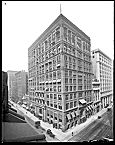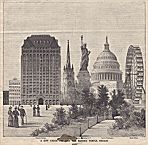| Entries |
| S |
|
Skyscrapers
|
The invention of the skyscraper in the late 1800s made possible the concentration of business and services that have in turn made Chicago the great metropolis of the interior United States.

|
Early skyscrapers were clothed in historical styles, but eventually the form's distinctive skeletal metal frame was fully expressed, as in the Second Leiter Building (1891), which showed the wall becoming more glass than stone. The luminous Reliance (1895), with its continuous horizontal bands of window, ended all pretense of supporting walls, anticipating the glass curtain wall of the next century.

|
By the 1980s postmodernists were creating visual excitement with all manner of historical references and contextual sensitivity. The graceful 333 Wacker (1983) gives and takes with the curve of the river, while the PaineWebber Tower (1990) revives a 1920s Saarinen design in scintillating contemporary garb. Chicago continues to be a living museum of the skyscraper, where the great architects of the world show their work.
The Encyclopedia of Chicago © 2004 The Newberry Library. All Rights Reserved. Portions are copyrighted by other institutions and individuals. Additional information on copyright and permissions.